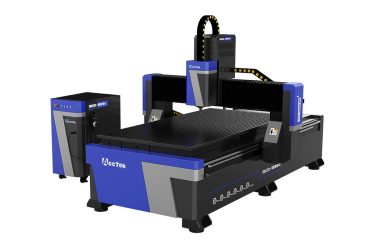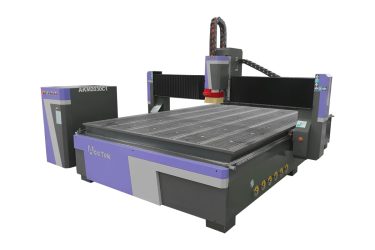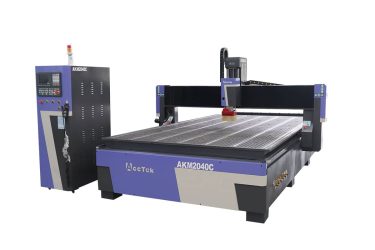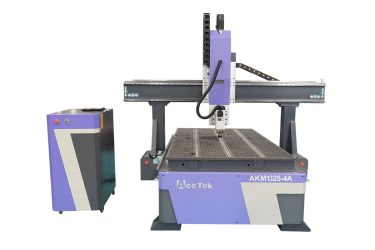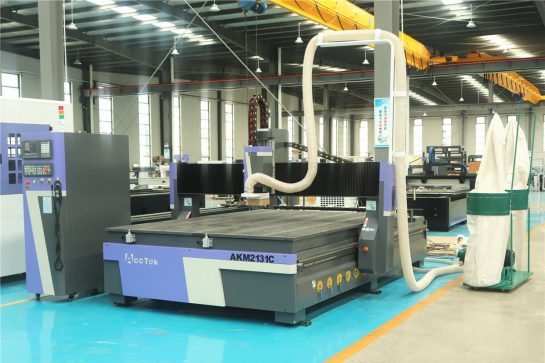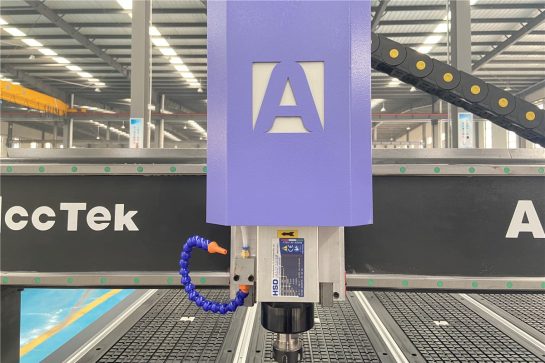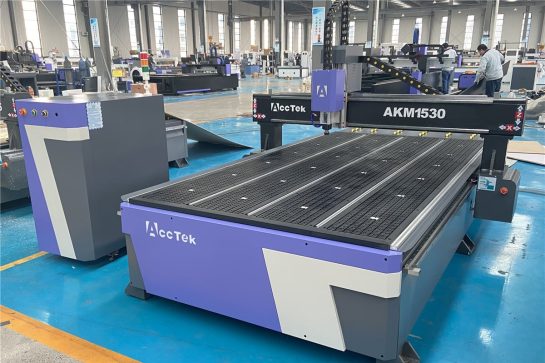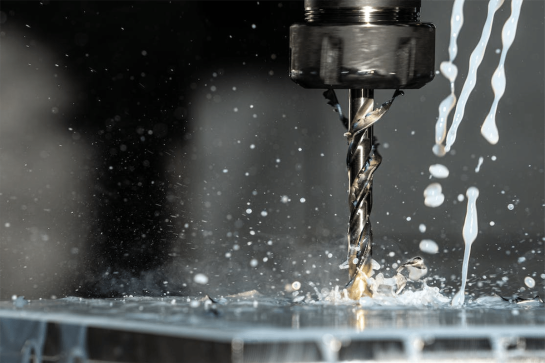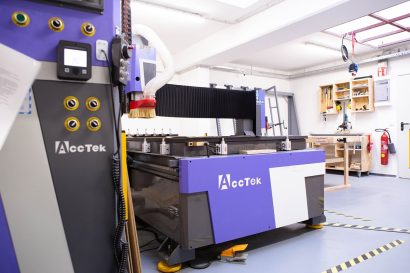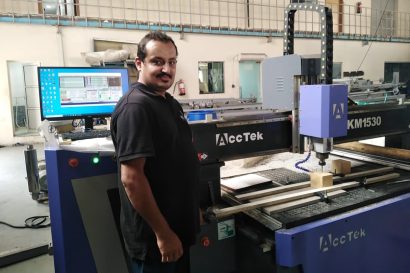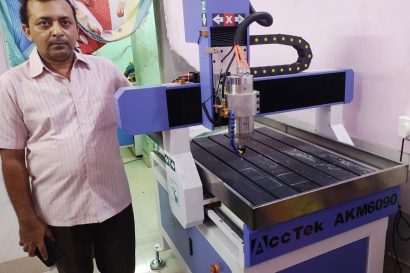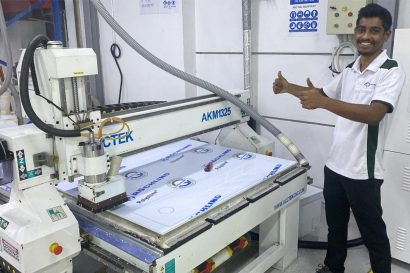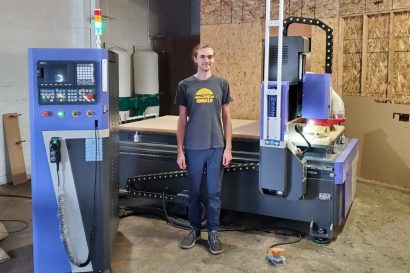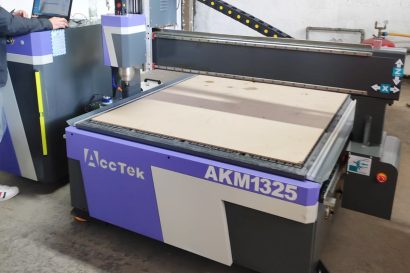CNC Router
Tips For Choosing The Right CNC Router
Application requirements
Material compatibility
Dimensions and bed capacity
Spindle power and speed
Accuracy and precision
Control systems and software
Tool changing ability
Build quality and rigidity
Dust removal system
Support and training
Comments and suggestions
Budget considerations
Advantages of CNC router
Precision and accuracy
CNC router excels in precision and accuracy, providing consistent and precise cuts. These machines utilize advanced technologies such as stepper or servo motors to ensure that each workpiece meets programmed specifications with high reliability.
Versatility
CNC routers offer versatility. It can efficiently process a variety of materials, including wood, plastics, metals, and composites. This adaptability makes it indispensable in industries with different material requirements.
Repeatability
CNC router has excellent repeatability. Once programmed, the machine can replicate the same design or cut repeatedly, ensuring consistency across multiple workpieces and minimizing variation in the final product.
Automation and efficiency
The automation features of the CNC router significantly increase efficiency. It operates continuously and requires minimal manual intervention. This automation reduces production time, making CNC routers ideal for prototyping and large-scale manufacturing.
Wide range of applications
CNC routers are widely used in various industries. Its versatility allows the creation of diverse products, making it invaluable in a variety of manufacturing processes, from woodworking and signage to aerospace and automotive.
Efficiency and speed
CNC routers significantly increase the efficiency and speed of the manufacturing process. Through fast and precise movements, it can complete tasks faster than traditional manual methods, helping to increase productivity, and making it ideal for prototyping and large-scale manufacturing.
Intricate designs and cuts
The ability to handle complex designs and complex cuts makes CNC routers stand out. Whether creating detailed engravings or intricate patterns, it can navigate complex paths with precision, achieving results that are difficult or impossible with manual methods.
Reduce waste
CNC router optimizes material usage and minimizes waste. The precision of the cutting path ensures efficient use of material, contributing to cost savings and environmental sustainability by reducing scrap and minimizing the need for additional raw materials.
Easy to reprogram
Reprogramming a CNC router is a simple process. This easy reprogramming allows for quick design adjustments, promoting agile responses to changing project needs without extensive downtime or reconfiguration.
Enhance security
CNC router improves workplace safety by minimizing direct operator involvement in the cutting process. Operators are less exposed to potential hazards associated with manual machining, contributing to a safer work environment.
Cost-effective production
Despite the initial investment, over time the CNC router proved cost-effective in production. Its efficiency, reduced waste, and ability to run continuously help reduce unit production costs, making it economically viable in both small- and large-scale operations.
Consistent quality
CNC router ensures consistent output quality. Its precision, repeatability, and automation enable all manufactured components to achieve standardized quality levels, enabling a reliable manufacturing process that meets the stringent requirements of various industries.
What Materials Can The CNC Router Cut?
Wood
- Pine
- Oak
- Maple
- Plywood
- MDF
- Cedar
- Teak
Plastics
- Acrylic
- PVC
- HDPE
- LDPE
- Polycarbonate
- PET
- PU
Metal
- Stainless Steel
- Carbon Steel
- Aluminum
- Brass
- Copper
- Titanium
- Gold
Others
- Rubber
- Carbon Fiber
- Laminates
- Leather
- Glass
- Stone
- Ceramics
Application Industry

Construction Industry
The integration of CNC routers into construction workflows has ushered in a new era characterized by meticulous detailing, rapid prototyping, and improved material utilization.

Aerospace Industry
The CNC router is widely used in aerospace engineering due to its unparalleled ability to carve complex designs, manufacture complex parts, and ensure tight tolerances.

Jewelry Industry
The CNC router revolutionize the way fine jewelry is designed and made by delivering unparalleled precision and efficiency and producing intricate designs with meticulous attention to detail.

Stone Carving Industry
The integration of CNC routers into the stone carving industry is not only revolutionizing the way craftsmen carve, it is also redefining the boundaries of artistic possibilities in this ancient practice.
Blog
How to Reduce the Impact of Workpiece Adhesion on CNC Router Cutting Quality
Addressing Environmental Concerns in CNC Router Waste Disposal: A Comprehensive Guide
Guide to Optimizing CNC Router Parameters for Diverse Materials
Understanding the Perils of Spindle Runout in CNC Routers
Mastering CNC Router Worktables: A Comprehensive Guide
CNC Router Bits: Complete Buyer’s Guide
Frequently Asked Questions
What does a CNC router do?
Is it worth buying a CNC router?
- Project Complexity: If your project involves complex designs, complex cuts, or repetitive tasks, a CNC router can significantly improve efficiency and accuracy compared to manual methods.
- Material Diversity: If you work with a variety of materials such as wood, plastic, metal, or composites, the versatility of the CNC router makes it a valuable tool, allowing you to work with different materials with ease.
- Workload: For high-volume production or projects with large numbers of identical components, the automation and repeatability of the CNC router can save time and costs.
- Precision Requirements: If your job requires high precision and accuracy, the CNC router’s computer-controlled motion ensures consistent and precise results that exceed the capabilities of manual methods.
- Customization Needs: If you frequently need to change designs or customize, the flexibility of a CNC router and the ease of reprogramming can save time and effort compared to manual adjustments.
- Skill Level: CNC routers do require some learning curve in programming and operation. If you or your team are willing and able to learn the necessary skills, the long-term benefits may outweigh the initial challenges.
- Budget Considerations: Evaluate your budget based on the cost of purchasing and maintaining a CNC router. Consider not only the initial investment but also ongoing costs such as tools, software, and potential maintenance.
- Saves Time: If time is a critical factor in your project, then a CNC router’s ability to complete tasks quickly and consistently can be a significant advantage that justifies the investment.
- Return on Investment (ROI): Evaluate potential return on investment. If the CNC router’s increased efficiency and functionality leads to greater productivity and new business opportunities, it may justify the initial investment.
- Space: Consider the space available in your workshop or facility. CNC routers come in various sizes, and you need enough space to accommodate the machine and its operations.
- Future Growth: Consider your future business or project needs. If you anticipate growing or expanding into more complex designs, a CNC router can provide the scalability and functionality needed to meet your changing needs.
How much does a CNC router cost?
- Hobby CNC Routers:
- Cost: Around $3000 to $8000
- Description: Designed for hobbyists and smaller-scale projects, hobby CNC routers offer a balance between affordability and functionality. They are suitable for users looking to explore CNC machining on a smaller budget.
- Standard 3-Axis CNC Routers:
- Cost: Approximately US$5,000 to $7,000
- Description: Standard 3-axis CNC routers are versatile machines capable of handling a variety of materials and applications. They provide a solid foundation for general CNC machining needs.
- ATC CNC Routers:
- Cost: Approximately US$11,000 to $22,000
- Description: Equipped with an Automatic Tool Changer (ATC), these routers are ideal for projects requiring multiple tools. The ATC enhances efficiency by automating tool changes, reducing downtime, and expanding the machine’s capabilities.
- 4-Axis CNC Routers:
- Cost: Approximately US$13,000 to $23,000
- Description: The 4-axis CNC router adds an axis that rotates the spindle to the standard 3-axis CNC router setup, allowing for more complex 3D machining functions.
- 5-Axis CNC Routers:
- Cost: Approximately US$63,000 to $75,000
- Description: Advanced and versatile, 5-axis CNC routers simultaneously move along five axes, enabling intricate and complex machining. They are often used for precision work in industries such as aerospace and automotive.
- Rotary Axis CNC Routers:
- Cost: Approximately US$3,500 to $10,000
- Description: Specifically designed for projects involving rotating cylindrical or irregularly shaped objects, rotary axis CNC routers offer enhanced versatility for applications such as engraving on cylindrical surfaces.
- Multi-Head CNC Routers:
- Cost: About US$7,000 to $12,000
- Description: Multi-head CNC routers come equipped with multiple tool heads, allowing for the simultaneous execution of various tasks. This feature increases efficiency and productivity, making them suitable for projects with diverse machining requirements.
Why are CNC routers so expensive?
- Precision And Technology: The CNC router is designed to provide high precision and advanced technical capabilities. Precision requires tight tolerances in the manufacturing process, and the integration of complex technologies such as computer control systems, motors, and high-quality components can increase overall costs.
- Materials And Construction: Premium materials and sturdy construction contribute to the durability and reliability of your CNC router. A strong frame, precision components, and a durable spindle determine the total cost.
- Automation Features: The CNC router with advanced features such as automatic tool changer (ATC), multi-axis motion (4 or 5 axes), and rotary or multi-head functions are more expensive due to the complexity of their design and the additional mechanisms required.
- Research And Development: The development of new technologies and improvements in CNC router design require significant R&D costs. These costs are often factored into the pricing of the final product.
- Brand Reputation: Well-known and reputable brands often command higher prices because of their track record of producing reliable and high-performance CNC routers. Brand reputation helps increase customer confidence and trust, which affects the pricing of machines.
- Customization Options: Some CNC routers offer customization options, allowing users to tailor the machine to their specific needs. Customization may involve additional costs for specialized features, tooling, or increased precision.
- Market Demand: The demand for CNC routers will affect its pricing. Due to market dynamics, high demand (especially for premium models) may result in price increases.
- Size And Features: Larger CNC routers with larger bed capacities and more advanced features tend to be more expensive. The size of the machine and the complexity of its functionality will affect the overall cost.
- High-Quality Components: Using high-quality components, such as precision ball screws, linear guides, and reliable electronics, increases cost but ensures the durability and accuracy of your CNC router.
What is the lifespan of a CNC router?
- Build Quality: The high-quality CNC router built with durable materials and components can have a longer service life. The sturdy frame, precision ball screw, and reliable motor contribute to the machine’s overall durability.
- Frequency of Use: The service life of the CNC router is affected by its frequency of use. Machines used for high-volume production or continuous operation may experience more wear and tear, which may affect service life.
- Maintenance Practices: Regular and proactive maintenance can significantly extend the life of your CNC router. Proper lubrication, routine inspections, and prompt repairs can prevent problems from escalating and help extend service life.
- Technological Advances: Rapid advancements in CNC technology may impact the perceived lifespan of a machine. While mechanical components may remain functional over time, software, control systems, and technical features may become obsolete, prompting users to consider upgrades or replacements.
- Upgrades And Retrofits: Some CNC routers can be upgraded or retrofitted with newer components, extending their functionality and lifespan. Upgrading the controller, adding new features, or replacing outdated parts can breathe new life into an older machine.
- Environmental Conditions: The operating environment of the CNC router will affect its service life. Machines that are exposed to extremes of temperature, humidity, or dust may experience accelerated wear. Providing a controlled and clean environment helps protect machines.
- Manufacturer Reputation: The reputation of a CNC router manufacturer can be an indication of the potential lifespan of the machine. Reputable manufacturers typically produce machines with higher build quality and provide better support, making the equipment more durable.
- User Training: Adequate training of users on proper machine operation and maintenance can impact the lifespan of a CNC router. Users who know how to operate their machines properly and perform routine maintenance are less likely to cause unnecessary wear and tear.
What are the risks of using a CNC router?
- Entanglement: There is a risk of entanglement in the moving parts of the CNC router, including the spindle and cutting tools. Loose clothing, jewelry, or long hair can get caught on these moving parts, causing serious injury.
- Cutting Tool Hazard: Cutting tools can cause injury if not handled properly. Sharp tools and high-speed rotation pose a risk of cutting, especially during tool changes or manual adjustments.
- Material Ejection: During cutting, machining or drilling, the CNC router generates chips, debris or dust that can be ejected. Operators must wear appropriate PPE (personal protective equipment) to prevent eye injuries and respiratory hazards.
- Noise And Vibration: The operation of the CNC router will produce noise and vibration. Prolonged exposure to high-noise environments may cause hearing damage, and vibration may affect the stability of the machine if not handled properly.
- Dust And Fume Exposure: Processing generates dust and fumes that may be harmful to the respiratory tract. Breathing in these particles can cause respiratory problems, so proper ventilation and dust collection systems are required.
- Electrical Hazards: CNC routers are powered by electricity and users may encounter electrical hazards if not handled properly. Regular maintenance and inspections can help identify and resolve any electrical problems.
- Tool Changing: Changing the tools on a CNC mill involves handling sharp objects. Carelessness when changing tools can result in cuts or injuries, so proper procedures need to be followed.
- Mechanical Hazard: Contact with moving parts such as spindles, cutting tools, or other machine components may result in injury. Users must avoid contact with the machine while it is in operation and use appropriate guards and barriers.
- Programming Errors: Errors or incorrect settings in the CNC program can cause unexpected tool paths, collisions, or workpiece damage. Check and simulate the program thoroughly before running it on your machine.
- Lack of Training: Inadequate training in CNC router operation and safety procedures can increase the risk of accidents. Proper training helps operators understand the machine’s capabilities and potential hazards.
- Machine Tipping or Overloading: Improper loading of materials or exceeding the machine’s load-bearing capacity may cause tipping or overloading, causing damage to the machine and posing safety risks.
What is the difference between a CNC router and a CNC machine?
- Scope of Application:
- CNC Machine: This term is a broad umbrella that includes a wide range of computer-controlled machines used for various purposes. CNC machines can include lathes, mills, plasma cutters, laser cutters, and more. They are employed in diverse industries for tasks such as milling, turning, welding, and additive manufacturing.
- CNC Router: A CNC router is a specific type of CNC machine primarily designed for cutting, carving, and engraving materials such as wood, plastic, metal, and composites. It is widely used in woodworking, signage, prototyping, and related industries.
- Functional Differences:
- CNC Machine: The term “CNC machine” doesn’t specify a particular function but refers to machines that are automated and controlled by computer programs. CNC machines can have different configurations and functions depending on their application.
- CNC Router: A CNC router is specifically designed for routing tasks, which involve cutting, shaping, and carving materials using a rotating cutting tool. CNC routers are well-suited for tasks that require precision and detail, making them popular in woodworking and related industries.
- Tooling and Cutting Methods:
- CNC Machine: Depending on the type of CNC machine, tooling and cutting methods can vary. CNC machines may use different types of tools, including drills, mills, lasers, or plasma cutters, depending on the intended application.
- CNC Router: CNC routers typically use a spindle with various cutting bits, allowing them to perform tasks such as milling, carving, and engraving. The cutting tools for CNC routers are tailored to materials like wood and plastics.
- Material Handling:
- CNC Machine: CNC machines can handle a wide range of materials, including metals, plastics, composites, and more, depending on the specific type of machine and its capabilities.
- CNC Router: CNC routers are well-suited for softer materials like wood, plastics, and foams. While they can work with certain metals and composites, their primary strength lies in tasks involving softer materials.
How noisy is a CNC router?
- Spindle Speed: The speed at which the spindle rotates affects noise levels. Higher spindle speeds may produce more noise, especially when cutting harder materials.
- Cutting Feed Rate: The rate at which the cutting tool moves over the workpiece (called the feed rate) affects noise. Faster cutting feed rates may result in increased noise during machining.
- Material Hardness: Machining harder materials such as metal will produce more noise than softer materials such as wood or plastic.
- Machine Design: The design of the CNC router (including the structure of the frame and the type of bearings used) affects the amount of vibration and noise transmitted during operation.
- Tools: The type of cutting tools used can affect noise levels. Different tool materials and geometries may produce different levels of sound during cutting.
- Enclosure or Open Design: Some CNC routers come with enclosures designed to suppress noise, while others have open designs. Enclosed machines often help suppress noise to some extent.
- Component Quality: The quality of components such as spindles, motors, and bearings can affect noise levels. Higher quality components generally contribute to smoother, quieter operation.
- Vibration Damping: An effective vibration-damping system can help reduce noise by minimizing the transmission of vibration from the cutting process to the machine structure.
What PPE is needed for a CNC router?
- Safety Glasses or Goggles: Eye protection helps protect against flying debris, chips, or dust generated during machining. Safety glasses or goggles with side shields provide adequate coverage.
- Earplugs or Earmuffs: CNC routers can produce high levels of noise, especially during cutting operations. Earplugs or earmuffs can help prevent potential hearing damage from long-term exposure.
- Dust Mask or Respirator: To prevent inhalation of dust and particles generated during processing, especially when working with wood, a dust mask or respirator with the appropriate filtration level is required.
- Work Gloves: Gloves protect sharp edges, splinters, or hot surfaces. However, care should be taken to select gloves that do not pose a risk of becoming entangled in the machine.
- Long Sleeves And Long Pants: Wearing long sleeves and long pants can provide additional protection from flying debris and coolant. Loose clothing should be avoided to prevent it from becoming entangled with the machine.
- Steel-Toe Safety Shoes: Sturdy, closed-toe steel-toe shoes protect feet in the event of dropped objects or accidental contact with machinery.
- Apron or Coveralls: An apron or coveralls can help protect clothing from dust, debris, and accidental contact with cutting tools or the machine itself.
- Hair Clips: For those with long hair, it is essential to secure your hair properly to prevent it from getting tangled with moving parts.
- Machine-Specific Guards And Barriers: Some CNC routers may be equipped with machine-specific guards or barriers designed to prevent direct contact with moving parts and ensure they are in place and functioning properly.
What limitations does a CNC router have?
- Material Limitations: While CNC routers can process a variety of materials, there are limitations on the types and hardness of materials they can effectively process. Extremely hard metals or materials that generate too much heat during cutting can present challenges.
- Tool Limitations: The CNC router is limited by the types and sizes of tools it can accommodate. Choosing the wrong tool for a specific material or application can result in poor performance.
- Precision And Tolerances: Achieving extremely tight tolerances can be challenging, especially for complex or small-scale designs. Factors such as tool deflection, machine stiffness, and material changes can affect accuracy.
- Limited Z-Axis Depth: Standard CNC routers may have limitations in Z-axis depth, limiting the height of the workpiece that can be accommodated. This can be a limitation for projects that require deep cutting or engraving.
- Manual Tool Change: CNC routers that lack an automatic tool changer (ATC) may require manual tool change. This process disrupts workflow and can be very time-consuming, especially on projects involving multiple tool types.
- Dust And Chip Collection: The CNC router generates a lot of dust and chips during the cutting process. While many machines have dust collection systems, managing and containing debris remains a challenge, impacting machine cleanliness and operator health.
- Learning Curve: Effective operation of a CNC router requires a learning curve. Users need to understand not only the operation of the machine but also how to program it using computer-aided design (CAD) and computer-aided manufacturing (CAM) software.
- Initial Cost: The upfront cost of purchasing a CNC router can be relatively high, especially for models with advanced features. For small businesses or hobbyists with a limited budget, this initial investment may be limiting.
- Maintenance Requirements: CNC routers require regular maintenance to ensure optimal performance. Neglecting maintenance tasks can lead to premature wear, affecting the accuracy and longevity of your machine.
- Software Compatibility: Compatibility with specific design and machining software may be a limitation. Ensuring that your CNC router is compatible with your preferred software helps achieve a seamless workflow.
- Noise And Vibration: CNC router will generate noise and vibration during operation. In environments where noise is a problem, additional measures may be needed to mitigate these effects.
- Limited Tolerance For Material Property Changes: Changes in material properties (such as density or hardness) may affect the performance of the CNC router. Material inconsistencies can affect the accuracy and quality of the final product.
- Complexity For Small Projects: For very small or simple projects, the complexity and functionality of a CNC router may be a bit overkill. In this case, simpler tools or methods may be more practical.





